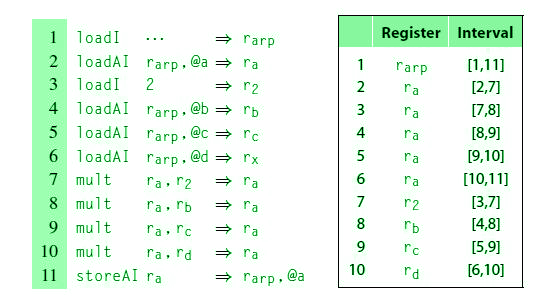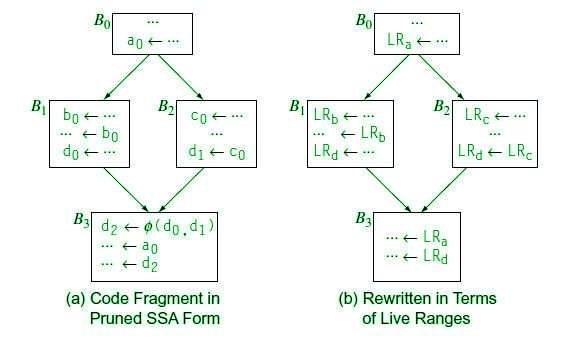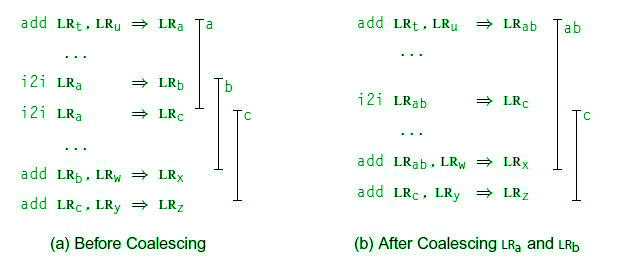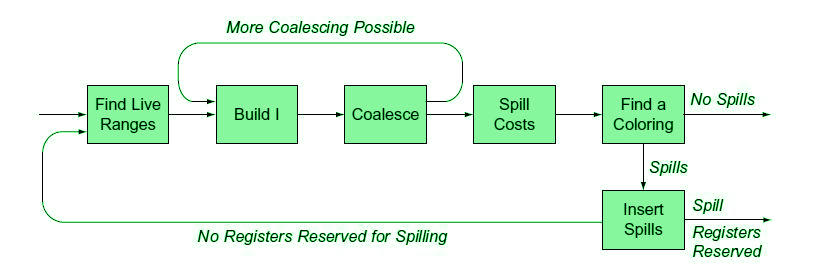How To Find Number Of Registers Given Memory And Addressability
Registers are the fastest locations in the memory bureaucracy. But unfortunately, this resource is limited. It comes under the most constrained resource of the target processor. Annals resource allotment is an NP-consummate problem. However, this problem tin be reduced to graph coloring to attain allocation and consignment. Therefore a good annals allocator computes an effective guess solution to a hard trouble.

Figure – Input-Output
The annals allocator determines which values will reside in the register and which register volition hold each of those values. Information technology takes as its input a plan with an capricious number of registers and produces a program with a finite register ready that can fit into the target machine. (Run into paradigm)
Allocation vs Assignment:
Resource allotment –
Maps an unlimited namespace onto that register set up of the target machine.
- Reg. to Reg. Model: Maps virtual registers to concrete registers but spills excess amount to memory.
- Mem. to Mem. Model: Maps some subset of the retentiveness location to a set up of names that models the physical register set.
Allocation ensures that lawmaking will fit the target auto'south reg. gear up at each instruction.
Assignment –
Maps an allocated name set to the physical annals set of the target machine.
- Assumes allotment has been done and so that code will fit into the fix of physical registers.
- No more than than 'grand' values are designated into the registers, where 'grand' is the no. of physical registers.
Full general register allocation is an NP-complete trouble:
- Solved in polynomial time, when (no. of required registers) <= (no. of available physical registers).
- An assignment can be produced in linear time using Interval-Graph Coloring.
Local Register Allocation And Assignment:
Resource allotment only inside a basic block is chosen Local Reg. Allocation. 2 approaches for local reg. allocation: Top-downwardly approach and bottom-upwardly approach.
Top-Down Approach is a unproblematic approach based on 'Frequency Count'. Identify the values which should be kept in registers and which should be kept in memory.
Algorithm:
- Compute a priority for each virtual register.
- Sort the registers into priority social club.
- Assign registers in priority gild.
- Rewrite the code.
Moving beyond single Blocks:
- More complicated because the control menstruum enters the picture.
- Liveness and Live Ranges: Live ranges consist of a set of definitions and uses that are related to each other as they i.e. no single annals tin be common in a such couple of instruction/data.
Following is a way to find out Live ranges in a block. A live range is represented as an interval [i,j], where i is the definition and j is the final use.
Global Register Allocation and Assignment:
i. The main issue of a register allocator is minimizing the impact of spill code;
- Execution fourth dimension for spill code.
- Code space for spill operation.
- Data space for spilled values.
2. Global resource allotment tin can't guarantee an optimal solution for the execution time of spill code.
three. Prime differences between Local and Global Allocation:
- The structure of a global live range is naturally more complex than the local one.
- Within a global live range, singled-out references may execute a unlike number of times. (When bones blocks form a loop)
4. To make the conclusion about allocation and assignments, the global allocator generally uses graph coloring by building an interference graph.
5. Register allocator then attempts to construct a k-coloring for that graph where 'grand' is the no. of concrete registers.
- In case, the compiler can't straight construct a k-coloring for that graph, it modifies the underlying code by spilling some values to memory and tries again.
- Spilling actually simplifies that graph which ensures that the algorithm will halt.
6. Global Allocator uses several approaches, still, nosotros'll see top-downwardly and bottom-up allocations strategies. Subproblems associated with the above approaches.
- Discovering Global live ranges.
- Estimating Spilling Costs.
- Building an Interference graph.
Discovering Global Live Ranges:
How to discover Live range for a variable?

Figure – Discovering live ranges in a single block
The above diagram explains everything properly. Permit's have the example of Rarp, information technology'due south been initialized at program point 1 and its concluding usage is at program point 11. Therefore, the Live Range of Rarp i.e. Larp is [1,11]. Similarly, others follow upwards.

Figure – Discovering Alive Ranges
Estimating Global Spill Price:
- Essential for taking a spill decision which includes – address computation, memory performance cost, and estimated execution frequency.
- For performance benefits, these spilled values are kept typically for the Activation records.
- Some embedded processors offer ScratchPad Memory to hold such spilled values.
- Negative Spill Toll: Sequent load-store for a single address needs to exist removed as it increases the brunt, hence incurs negative spill cost.
- Infinite Spill Cost: A live range should take infinite spill price if no other live range ends betwixt its definition and its use.
Interference and Interference Graph:

Figure – Building Interference Graph from Alive Ranges
From the above diagram, it can be observed that the live range LRA starts in the first basic block and ends in the last basic block. Therefore it will share an border with every other live Range i.east. Lrb, Lrc,Lrd. However, Lrb, Lrc, Lrd doesn't overlap with any other live range except Lra so they are only sharing an border with Lra.
Building an Allocator:
- Note that a k-colorable graph finding is an NP-complete trouble, so we need an approximation for this.
- Try with live range splitting into some not-piddling chunks (near used ones).
Pinnacle-Down Colouring:
- Tries to colour live range in an order determined by some ranking functions i.e. priority based.
- If no color is available for a alive range, the allocator invokes either spilling or splitting to handle uncolored ones.
- Alive ranges having k or more than neighbors are chosen constrained nodes and are difficult to handle.
- The unconstrained nodes are comparatively like shooting fish in a barrel to handle.
- Treatment Spills: When no colour is found for some live ranges, spilling is needed to be done, but this may not exist a final/ultimate solution of course.
- Live Range Splitting: For uncolored ones, split the live range into sub-ranges, those may have fewer interferences than the original one so that some of them can be colored at least.
Chaitin'due south Thought:
- Choose an arbitrary node of ( degree < k ) and put information technology in the stack.
- Remove that node and all its edges from the graph. (This may decrease the caste of some other nodes and crusade some more nodes to have degree = k, some node has to be spilled.
- If no vertex needs to exist spilled, successively popular vertices off the stack and color them in a color non used by neighbors. (reuse colors as far equally possible).
Coalescing copies to reduce degree:
The compiler tin utilise the interference graph to coalesce ii live ranges. And then past coalescing, what type of benefits can you become?

Figure – Coalescing Live Ranges
Comparison Top-Down and Bottom-Upwards allocator:
- Height-downward allocator could adopt the 'spill and iterate' philosophy used in bottom-up ones.
- 'Spill and iterate' trades additional compile time for an allocation that potentially, uses less spill code.
- Top-Downwardly uses priority ranking to social club all the constrained nodes. (Withal, it colors the unconstrained nodes in arbitrary guild)
- Bottom-upwards constructs an guild in which most nodes are colored in a graph where they are unconstrained.

Figure – Coalescing Live Ranges
How To Find Number Of Registers Given Memory And Addressability,
Source: https://www.geeksforgeeks.org/register-allocations-in-code-generation/
Posted by: nickersonwherenot.blogspot.com


0 Response to "How To Find Number Of Registers Given Memory And Addressability"
Post a Comment